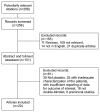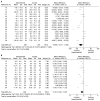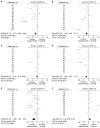Meta-Analysis: Effects of Zinc Supplementation Alone or with Multi-Nutrients, on Glucose Control and Lipid Levels in Patients with Type 2 Diabetes
- PMID: 31008092
- PMCID: PMC6456233
- DOI: 10.3746/pnf.2019.24.1.8
Meta-Analysis: Effects of Zinc Supplementation Alone or with Multi-Nutrients, on Glucose Control and Lipid Levels in Patients with Type 2 Diabetes
Abstract
The present study aims to assess the effects of zinc supplementation on metabolic parameters in patients with type 2 diabetes. A literature search was conducted in PubMedTM, Google ScholarTM, and ScopusTM up to March 2018. Twenty randomized controlled trials met the predefined inclusion criteria and were included in the meta-analysis. Weighted mean difference (WMD) with 95% confidence intervals (CIs) were calculated for net changes in glycemic indices including fasting blood glucose (FBG) and hemoglobin A1c (HbA1c), and in lipid markers including total cholesterol (TC), triglyceride (TG), low-density lipoprotein cholesterol (LDL-c), and high density lipoprotein cholesterol (HDL-c). Subgroup analyses were performed based on intervention and study quality. Compared to controls, zinc supplementation significantly reduced the concentrations of both FBG and HbA1c (FBG WMD: -19.66 mg/dL, 95% CI: -33.71, -5.62; HbA1c WMD: -0.43 mg/dL, 95% CI: -0.80, -0.07). The pooled estimate showed a significant decrease in serum TC and LDL-c, and increase in serum HDL-c levels in treatment group compared with the control group (TC WMD: -18.51 mg/dL, 95% CI: -21.36, -15.66; LDL-c WMD: -4.80 mg/dL, 95% CI: -6.07, -3.53; HDL-c WMD: 1.45 mg/dL, 95% CI: 1.40, 1.51). Subgroup analysis of "no co-supplement" intervention demonstrated significant differences for mean changes in HDL-c and FBG levels, whereas subgroup analysis of high quality studies showed significant differences for mean changes of LDL-c, HDL-c, and FBG levels. Results suggested that zinc supplementation reduces FBG, HbA1c and LDL-c levels and increases HDL-C levels; however, these changes were related to intervention and quality of studies.
Keywords: glycemic status; lipid profile; meta-analysis; type 2 diabetes; zinc supplementation.
Conflict of interest statement
AUTHOR DISCLOSURE STATEMENT The authors declare no conflict of interest.
Figures






Similar articles
-
Effects of Prebiotic and Synbiotic Supplementation on Glycaemia and Lipid Profile in Type 2 Diabetes: A Meta-Analysis of Randomized Controlled Trials.Adv Pharm Bull. 2018 Nov;8(4):565-574. doi: 10.15171/apb.2018.065. Epub 2018 Nov 29. Adv Pharm Bull. 2018. PMID: 30607329 Free PMC article. Review.
-
Effect of zinc supplementation in the management of type 2 diabetes: A grading of recommendations assessment, development, and evaluation-assessed, dose-response meta-analysis of randomized controlled trials.Crit Rev Food Sci Nutr. 2024;64(25):9228-9239. doi: 10.1080/10408398.2023.2209802. Epub 2023 May 15. Crit Rev Food Sci Nutr. 2024. PMID: 37183697
-
Effects of intermittent fasting and energy-restricted diets on lipid profile: A systematic review and meta-analysis.Nutrition. 2020 Sep;77:110801. doi: 10.1016/j.nut.2020.110801. Epub 2020 Mar 12. Nutrition. 2020. PMID: 32428841
-
Beneficial effects of folic acid supplementation on lipid markers in adults: A GRADE-assessed systematic review and dose-response meta-analysis of data from 21,787 participants in 34 randomized controlled trials.Crit Rev Food Sci Nutr. 2022;62(30):8435-8453. doi: 10.1080/10408398.2021.1928598. Epub 2021 May 18. Crit Rev Food Sci Nutr. 2022. PMID: 34002661
-
The Effect of Curcumin on Lipid Profile and Glycemic Status of Patients with Type 2 Diabetes Mellitus: A Systematic Review and Meta-Analysis.Evid Based Complement Alternat Med. 2022 Jun 17;2022:8278744. doi: 10.1155/2022/8278744. eCollection 2022. Evid Based Complement Alternat Med. 2022. PMID: 35754684 Free PMC article.
Cited by
-
Diabetic cardiomyopathy - Zinc preventive and therapeutic potentials by its anti-oxidative stress and sensitizing insulin signaling pathways.Toxicol Appl Pharmacol. 2023 Oct 15;477:116694. doi: 10.1016/j.taap.2023.116694. Epub 2023 Sep 20. Toxicol Appl Pharmacol. 2023. PMID: 37739320 Free PMC article. Review.
-
The Role of Zinc Homeostasis in the Prevention of Diabetes Mellitus and Cardiovascular Diseases.J Atheroscler Thromb. 2021 Nov 1;28(11):1109-1122. doi: 10.5551/jat.RV17057. Epub 2021 Jun 19. J Atheroscler Thromb. 2021. PMID: 34148917 Free PMC article. Review.
-
Efficacy and Safety of Nutrient Supplements for Glycaemic Control and Insulin Resistance in Type 2 Diabetes: An Umbrella Review and Hierarchical Evidence Synthesis.Nutrients. 2022 May 30;14(11):2295. doi: 10.3390/nu14112295. Nutrients. 2022. PMID: 35684094 Free PMC article.
-
Relationships Between Indicators of Metabolic Disorders and Selected Concentrations of Bioelements and Lead in Serum and Bone Tissue in Aging Men.Diabetes Metab Syndr Obes. 2022 Dec 14;15:3901-3911. doi: 10.2147/DMSO.S387444. eCollection 2022. Diabetes Metab Syndr Obes. 2022. PMID: 36540347 Free PMC article.
-
Effect of Zinc Supplementation on Lipid Profile and Body Composition in Patients with Type 2 Diabetes Mellitus: A GRADE-Assessed Systematic Review and Dose-Response Meta-analysis.Biol Trace Elem Res. 2024 Nov;202(11):4877-4892. doi: 10.1007/s12011-024-04059-x. Epub 2024 Jan 15. Biol Trace Elem Res. 2024. PMID: 38224402
References
-
- Alwan A. Global status report on noncommunicable diseases 2010. World Health Organization; Geneva, Switzerland: 2011. pp. 102–104.
LinkOut - more resources
Full Text Sources
Miscellaneous
